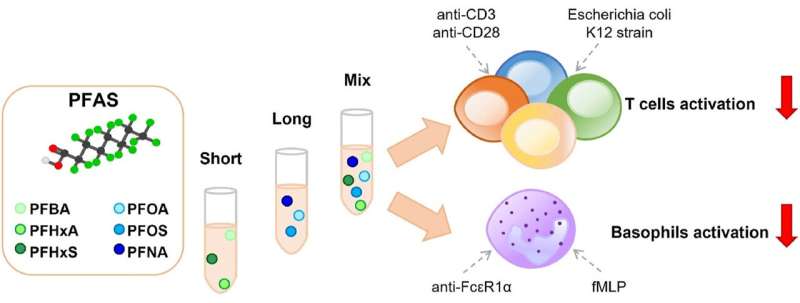This article has been reviewed according to Science X's editorial process and policies. Editors have highlighted the following attributes while ensuring the content's credibility:
fact-checked
peer-reviewed publication
trusted source
proofread
PFAS shown to reduce the activity of immune cells

PFAS are used in many everyday products. This is because PFAS are water- and fat-repellent, heat resistant, and extremely durable. PFAS have been produced since the 1950s and there are now around 10,000 different compounds.
"PFAS are poorly to hardly biodegradable—and that is a real problem", says UFZ environmental immunologist Dr. Gunda Herberth. "They therefore accumulate in the environment—in soils and bodies of water. They can even be found in Antarctica. They can enter the human body via food, drinking water, or the air. Studies have shown that PFAS can be detected in the blood of almost everyone in the world. What this means for our long-term health is not yet known."
However, exposure to PFAS is known to cause liver damage, hormonal disorders and lower birth weights. Many epidemiological studies have shown an association between increased PFAS exposure and reduced immune responses after childhood vaccinations. Could PFAS be affecting our immune systems? And if so, how exactly? What happens in the immune cells? These were the questions that Gunda Herberth and further scientists set out to answer in their study.
Targeted look inside immune cells
To find out exactly what happens at the cellular level after PFAS exposure, the researchers used a special immunological measurement method they developed. "Using multiparameter spectral flow cytometry, we can detect up to 30 markers in a blood sample using different fluorescent dyes and thus identify many different immune cell types and their activation," explains UFZ environmental immunologist Dr. Arkadiusz Pierzchalski, who developed the method together with Gunda Herberth.
The team used immune cells from the blood of healthy donors. First, the isolated immune cells were exposed to different PFAS mixtures for 20 hours in the laboratory. "We selected six PFAS that are particularly common in the environment and prepared three mixtures. One mixture with three short-chain PFAS, one with three long-chain PFAS and one with all six PFAS," explains Ambra Maddalon, a toxicologist at the University of Milan and first author of the study with Arkadiusz Pierzchalski.
"The immune cells were then stimulated using standard activation methods. The researchers then determined how active they were at the cellular level by using multi-parameter spectral flow cytometry."
PFAS significantly reduce the activity of T cells
The result: immune cells previously exposed to PFAS showed significantly lower activity than untreated cells. This was particularly true of T-cells. "For example, the T-cells produced less of the messenger substances they normally use to communicate with each other and to recruit other immune cells or to trigger inflammation," says Gunda Herberth.
"The strongest effects occurred when all six PFAS were mixed. Here, the effects of the different PFAS are clearly compounded. PFAS reduced the activity of two out of five types of immune cells in particular: MAIT cells (mucosa-associated invariant T cells) and T-helper cells. MAIT cells are found in the mucous membranes and form the first effective defense response."
"If the activity of MAIT cells is restricted, it is much easier for pathogens to invade the body," says Herberth. "T-helper cells are involved in the production of antibodies. If they are inhibited by PFAS, it is likely that fewer antibodies are produced—which could explain the reduced immune response to vaccination."
Further investigations carried out at the genetic level were consistent with the results at the cellular level: genes that normally play a role in T-cell activation were down-regulated after PFAS exposure. "Our study clearly shows that PFAS reduce the activity of immune cells," says Herberth. "If a person is exposed to high levels of PFAS, this is likely to be reflected in their health. For example, through a higher susceptibility to infections."
The immunomodulating effect should not be underestimated
In February 2023, the European Chemicals Agency (ECHA) published a proposal to further restrict the use of PFAS. A decision by the European Commission is expected in 2025. "Unfortunately, even if PFAS are completely banned, they will not disappear from the environment any time soon," says Herberth.
"It is therefore important to gain a better understanding of the effects these substances can have on our health. In further studies, the UFZ team plans to simulate in vitro PFAS mixtures and concentrations as they occur 'naturally' in human blood and determine their effects on immune cells."
"So far, tests for immunotoxic or immunomodulatory effects are not part of the regulatory testing and assessment procedures for chemicals. However, as many diseases—from allergies to cancer—can be traced back to a dysregulated immune system, we believe this is urgently needed," says Herberth. "We hope that with our study and our new and practical testing method, we can help pave the way for this to happen."
The research is published in the journal Chemosphere.
More information: Ambra Maddalon et al, Mixtures of per- and poly-fluoroalkyl substances (PFAS) reduce the in vitro activation of human T cells and basophils, Chemosphere (2023). DOI: 10.1016/j.chemosphere.2023.139204


















